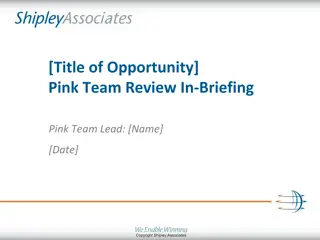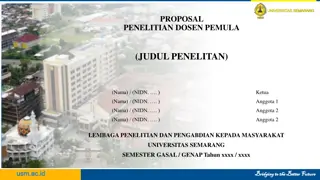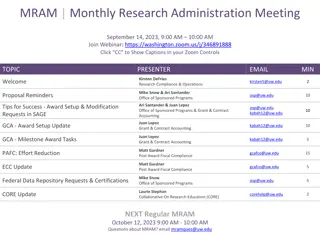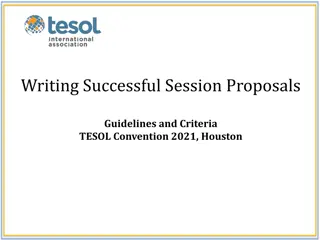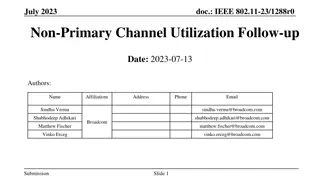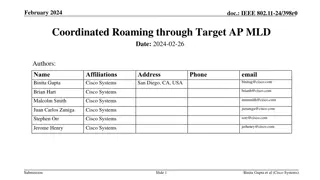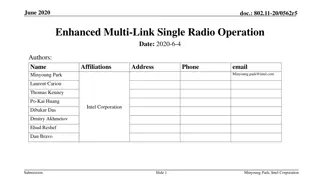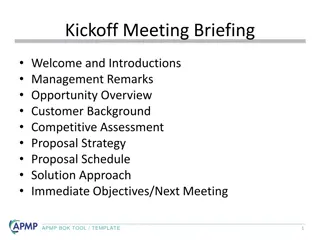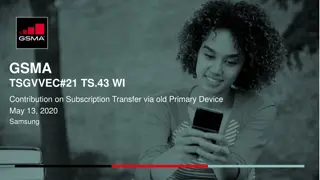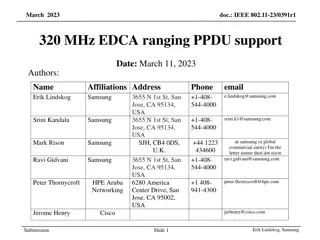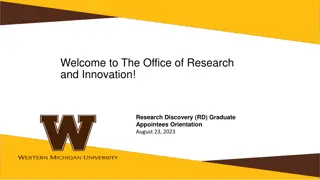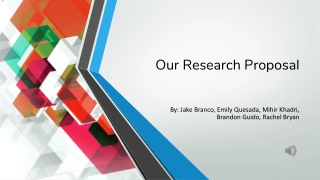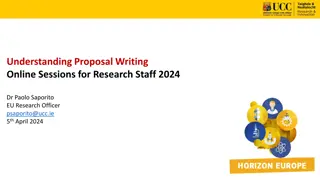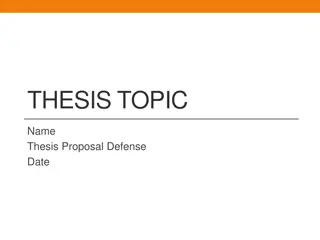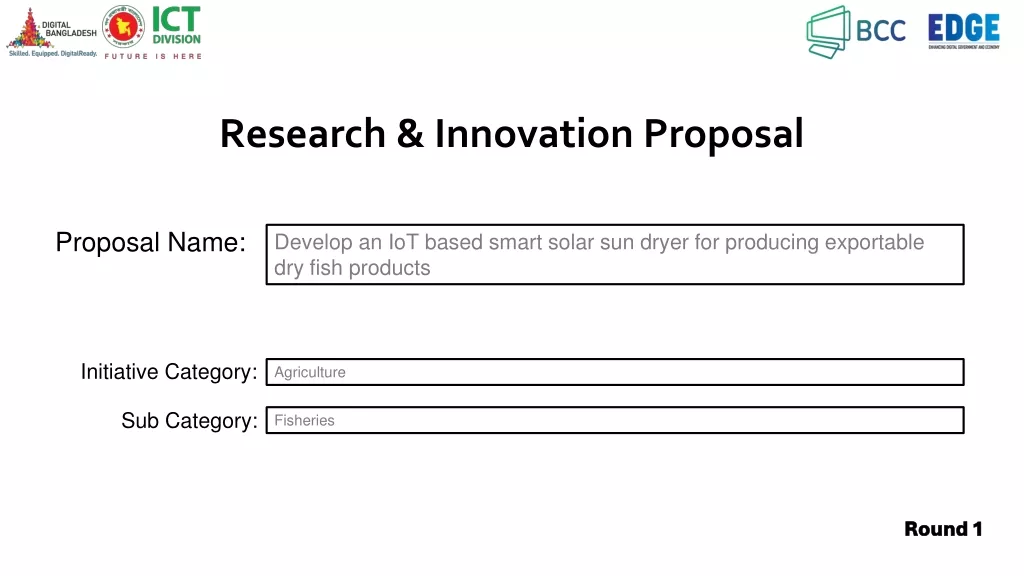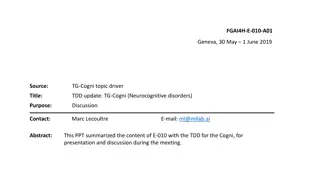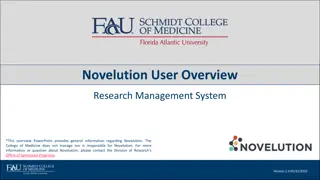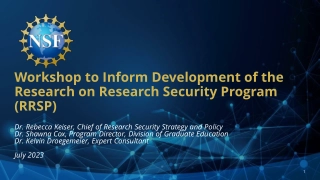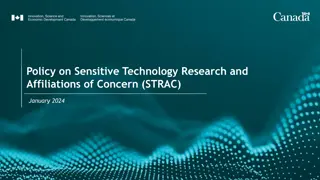Research Team 4 Proposal
Exploring the qualities of instructor-student communication that contribute to a comfortable online learning environment post-pandemic. The research delves into factors like flexibility, autonomy, timely feedback, and collaborative learning to promote student success in online courses. Supported by a literature review highlighting the significance of positive communication dynamics in online education.
Download Presentation

Please find below an Image/Link to download the presentation.
The content on the website is provided AS IS for your information and personal use only. It may not be sold, licensed, or shared on other websites without obtaining consent from the author. Download presentation by click this link. If you encounter any issues during the download, it is possible that the publisher has removed the file from their server.
E N D
Presentation Transcript
Research Team 4 Proposal Devyne Davis, Brian Gomez Jr., Ashlyn Martin, & Ciera Ravelo
(1A) The Question Which qualities of instructor-student communication promote a comfortable online learning environment?
(1B) Why this Question? We define the construct of comfort as a student s positive outlook, or that they can (a) obtain the grade they want and (b) have a clear understanding of course expectations, to move swiftly through the course. Our research question is at the heart of online education for students enrolled in college degree programs. This is especially so post-pandemic. In 2020, colleges and universities made big changes to accommodate remote learning by offering more online classes. Because student success is the number one goal of the university, assessing students comfort in an online classroom is directly tied to success. Communication constitutes our identities as learners, so it is important to look at how it actively plays a role in the basis of our progress and success as students. As USF s core student success model incorporated the collaboration of employees from across the university, the ownership of student success clearly shifted from being that of any one office to becoming the responsibility of all employees - USF Office of Student Success (University of South Florida - Student Success)
(2) Literature Backing Our literature review covers student-instructor communication and timing in online learning in recent years and demonstrates that our project is both timely and important. The following sources will show the extent to which communicative dynamics enable student comfort in the online learning environment.
(2) Literature Review Andrade supports our notion as to why it s important to know what will allow students to feel like they can succeed and actually do so in their online course, especially in the post- pandemic college setting. Some of the major factors that are discussed as vital to pedagogical retooling are flexibility, specifically delivery, time, and place (Andrade, 2016, p. 86). It also stresses the importance of allowing learners to feel autonomous in their learning yet maintaining it as a collaborative effort between learner and instructor through practice and the creation of communities. Soffer provides research evidence to support the positive outcomes that can stem from online course delivery. In the study of 968 participants, online students achieved higher final grades, with the same completion rates as the traditional, in-person course equivalent (Soffer, 2018). This is important to our research because it proves a basis as to why taking a deeper dive into online learning is necessary, as well as what promotes that positive outcome. This correlates to our study because we are trying to identify some of those same, and different, qualities that help online students succeed. Lastly, Kedia discusses the importance of timely responses when it comes to instructor interaction with both students and their work. Instructor instruction, feedback, and review are essential to producing student engagement and success (Kedia, 2023). These are exactly some of the answers that we are trying to get back in our research but with the main difference that we are looking at student feelings versus just their success. Overall, it ties into what matters most to students in regard to instructor communication that betters their relationship and vice versa. Dickinson completed another study that correlates directly to the relationship between student and instructor. Although demographic of students was a factor, Dickinson focuses primarily on the importance of emails and announcements from instructors, especially the instructor s tone in the messages (Dickinson, 2017). This is important literature backing because it supports our concern with relationship and communication in the online educational environment between the two main parties - instructor and student.
(3) Data & Methods We will collect data via technological resources, such as Microsoft Teams and Google Forms. With our targeted audience being past and current online college students, we can reach an abundance of potential participants. By creating a link with a contract for them to agree to the stipulations of our study, we will request that they complete any and all surveying and interviewing requests that we send to them to receive the incentive. In return for their participation, they will receive a gift card to a place of their choosing from our list of options. We feel good that we can get enough traction to have a large population to draw data from to obtain the information that we are looking for even if all that sign up do not follow through with all study requirement.
(3) Data & Methods Interviewing Surveying How to Employ: The best way to distribute our survey is through online promotion and distribution. Our social media accounts and chat forums are places where we have access to so many people, possibly even around the world. Participants don't even have to take much time out of their day to participate in surveys nor leave the comfort of their homes to do so. How to Employ: A way to employ these questions is through online courses announcements and discussion boards. If group members and fellow classmates share these questions to all of their online classes, it could be an opportunity to collect many answers and get multiple answers and opinions about students' online learning experience. This gives us access to people in closer proximity with the potential to work both online and in-person. Reasoning: 1) Surveys are great because of how many people they are able to reach. There are so many mediums for surveys in our digital world so you can reach an exponential amount of people. There is so much power in being able to reach such a large population of people because it is more representative of the subjects trying to be represented and measured. 2) They are extremely affordable. There are so many mediums for conducting surveys with how advanced our technology is to allow our world to be so interconnected. We have the world at our fingertips by just holding our smartphones and interacting with social media. I don't think we truly realize just how many people we are interacting with via our social media platforms, let alone how much we are actually conducting surveys. Reasoning: This method allows us to focus on getting answers to questions centered and focus on all parts of our research question. They allow us to understand how students feel during online classes and give us a chance to hear about some online experiences. It includes opportunities for written testimony and numerical data.
(3) Data & Methods Questions to Ask Participants Interviewing Surveying 1. Do you think that the online course delivery puts a hindrance on instructor-student communication? What components regarding instructor communication could boost your chances of success? What relationship aspects do you feel are good or poor within the online learning environment? 1. Do you feel comfortable in the online learning environment? How confident are you in your ability to communicate effectively in online discussions and forums? Are you comfortable using digital communication tools (emails, chat platforms, video conferencing) for academic purposes? 2. 2. 3. 3.
(3) Data & Methods Our unit of analysis is numerical by participant count, meaning that we will be categorizing responses by commonalities and linking numerical values (of participants) to them. Identifying these patterns in the responses we get that are not already generated into numerical data is going to be important. Through rereading, it s important to be able to categorize the opinions in the right way to truly get the type of feedback that we are searching for, as well as share it in a collective and comparative way. The questions in our codebook are as follows: 1. Is this a negative or positive opinion? 2. Is this a majority or minority opinion? 3. How many of the participants chose online learning?
(4) The Practical Outcome Our project will help to further our social world by improving our ever-changing learning environment. It will have a positive impact on how students and instructors conduct communication and interact in the online learning environment, which seems to only be growing. Everybody deserves the flexibility that stems from online learning, but it is important that their learning and success not fall victim due to a lack of understanding of what each party needs to be comfortable in this learning environment, especially if they did not choose that setting for themselves. . Based on our literature review, most of the issues in an online classroom amount to instructor and technological hardships that exist due to the transition, sometimes abrupt and sudden, to online learning. Our project is aimed to be able to work as a how-to for bettering the online learning environment for students by providing instructors and and universities with the necessary feedback to make the necessary changes in their practices. We hope to bridge a gap that exists in the academy as it pertains to instructor-student relationships, communication, and comfort in online learning by sharing our study findings with colleges and universities everywhere through an online publication, giving global access to our study s results.
References Andrade, M. S. (2016). Online Learning: Strategies for Pedagogical Retooling. CSEDU (2), 85-90. Dickinson, A. (n.d.). Communicating with the online student: The impact of e-mail tone ... - ed. https://files.eric.ed.gov/fulltext/EJ1150571.pdf. Kedia, Mishra. (2023). Exploring the factors influencing the effectiveness of online learning: A study on college students. https://www.ncbi.nlm.nih.gov/pmc/articles/PMC10199747/ Soffer, T, Nachmias, R. (2017). Effectiveness of learning in online academic courses compared with face-to-face courses in higher education. J Comput Assist Learn. 2018; 34: 534 543. https://doi.org/10.1111/jcal.12258 University of South Florida - Student Success. About Us. USF, www.usf.edu/student-success/about-us/. Accessed 27 Nov. 2023.


